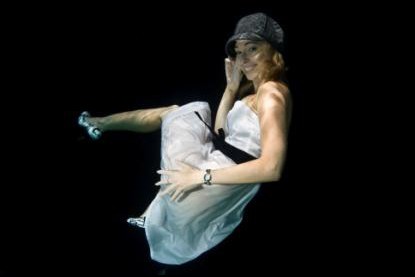Underwater Model Photography
Underwater model photography is also referred to as underwater studio photography or underwater pool photography. Basically, underwater model photography refers to underwater photography conducted in a controlled environment (such as a pool) with designated underwater models. A controlled environment facilitates the use of advanced lighting techniques such as underwater umbrellas and off-camera strobes. Furthermore, the use of a controlled environment enables the underwater photographer to manipulate the shoot by adding in his or her own creative element. Here I will discuss a few elements that an underwater model photographer can use to get the most out of their underwater pool shoot.
All photos are copyrighted by Cal Mero.
Models
 Arguably the single most important feature to a successful shoot will be the model. No matter how good the lighting, concept or creativity applied to a shoot, if the model isn’t comfortable in the water your unlikely to get quality results. The most important feature of a successful underwater model will be their eyes. If the model has difficulty opening their eyes underwater then most (if not all) of the shots will have the model squinting, which dampens the overall quality of an image.
Arguably the single most important feature to a successful shoot will be the model. No matter how good the lighting, concept or creativity applied to a shoot, if the model isn’t comfortable in the water your unlikely to get quality results. The most important feature of a successful underwater model will be their eyes. If the model has difficulty opening their eyes underwater then most (if not all) of the shots will have the model squinting, which dampens the overall quality of an image.
An additional factor too look out for is models who are noticeable holding their breath. This may not be apparent during the shoot but it will defiantly be noticeable in post production.
Finally, depending on your concept or idea, a smile can add a great element to a photo. Smiles generally draw the eye in to the model and if they’re well lit, they can make an average photo into a great photo. It may take the model some practice, but try to encourage the expression of emotion when modeling underwater.
Clothing for underwater models
Clothing (or lack thereof) is an integral part of a successful underwater shoot. It depends entirely on your aim or idea but generally try to use clothes that are loose or slightly too big. This allows them to move around underwater and adds a sense of movement and really accentuates that the shoot was taken underwater. An easy way to really emphasize the underwater element of the shoot is to use fabric as a “streamer.”
The use of clothing can also add a colour element to a shoot. Bright vivid clothing or darks/whites add a distinctive compositional element. An easy way to create a strong image is to contrast the clothing colour with the background. For example, a strong red dress against a black background creates great contrast.


Lighting Underwater Models:
Lighting can often be the biggest difference between an average shot and a great shot. Here are a few lighting techniques:
A single strobe held out wide from the model and pointing in can cause strong directional lighting.
-

A torch pointed at the subject can create great highlights
A single strobe above the water pointing down can create great ripples (if the surface is agitated)
Two strobes facing forward gets the strongest lighting but is often the least dramatic or directional
Pools are often quite shallow so try shooting at midday for the strongest natural lighting (outdoors) for some cool ripples
Don’t be afraid to use the ambient light in a pool at night. Often pools have their own mood lighting, which can look great if used correctly.


Creative compositions
Reflections are an easy way to create unusual and stunning imagery.
Here a few tips for shooting reflections:
Wait till the surface has flattened out before taking your shot to ensure the sharpest and most defined reflection
Position a strobe above water to generate light ripples
Have the model position their knees over the edge of the pool for close up reflections
For full body shots, use the widest lens you can to get close and maximize on your lighting
Face a strobe towards the reflection to brighten it up


Summary

The best part about composing an image underwater is taking advantage of buoyancy. Some great shots can be made by getting an underwater model or object to appear weightless. Try getting your model to free fall or glide down beneath the surface. These gestures combined with streamers or clothes can make for some stunning results.
Above all, underwater studio/pool photography opens up a new playing field of creativity to the underwater photographer. All the tricks you learn in the pool can be directly applied to your next wildlife shoot.


Dive Models in the Ocean
Further Reading
Underwater Pool Photography by Ron Watkins
Understanding underwater strobes, lighting and diffusers
Over under split shot underwater photography

RECOMMENDED ARTICLES
SUPPORT THE UNDERWATER PHOTOGRAPHY GUIDE:
The Best Service & Prices on u/w Photo Gear
 Visit Bluewater Photo & Video for all your underwater photography and video gear. Click, or call the team at (310) 633-5052 for expert advice!
Visit Bluewater Photo & Video for all your underwater photography and video gear. Click, or call the team at (310) 633-5052 for expert advice!
The Best Pricing, Service & Expert Advice to Book your Dive Trips
 Bluewater Travel is your full-service scuba travel agency. Let our expert advisers plan and book your next dive vacation. Run by divers, for divers.
Bluewater Travel is your full-service scuba travel agency. Let our expert advisers plan and book your next dive vacation. Run by divers, for divers.
































